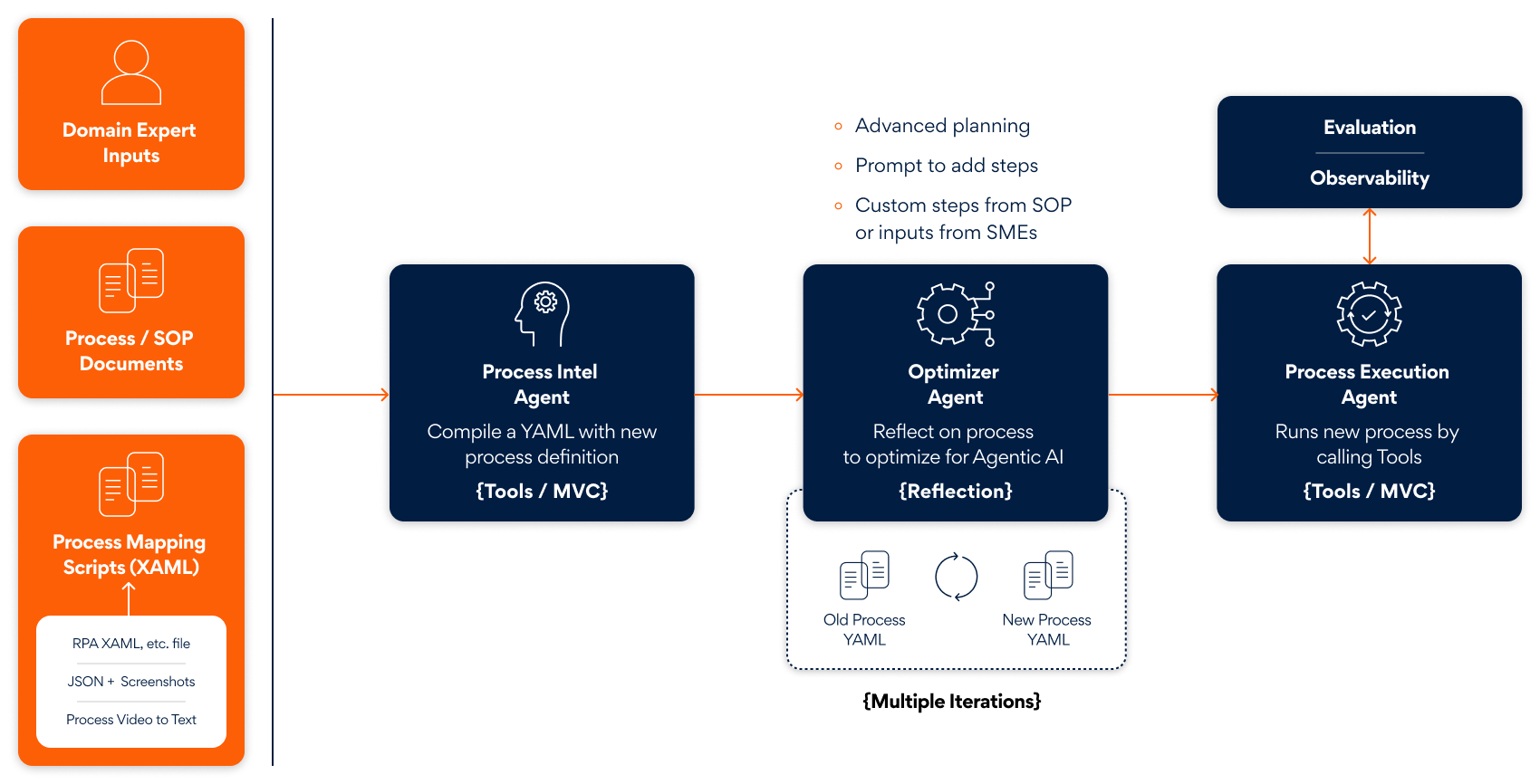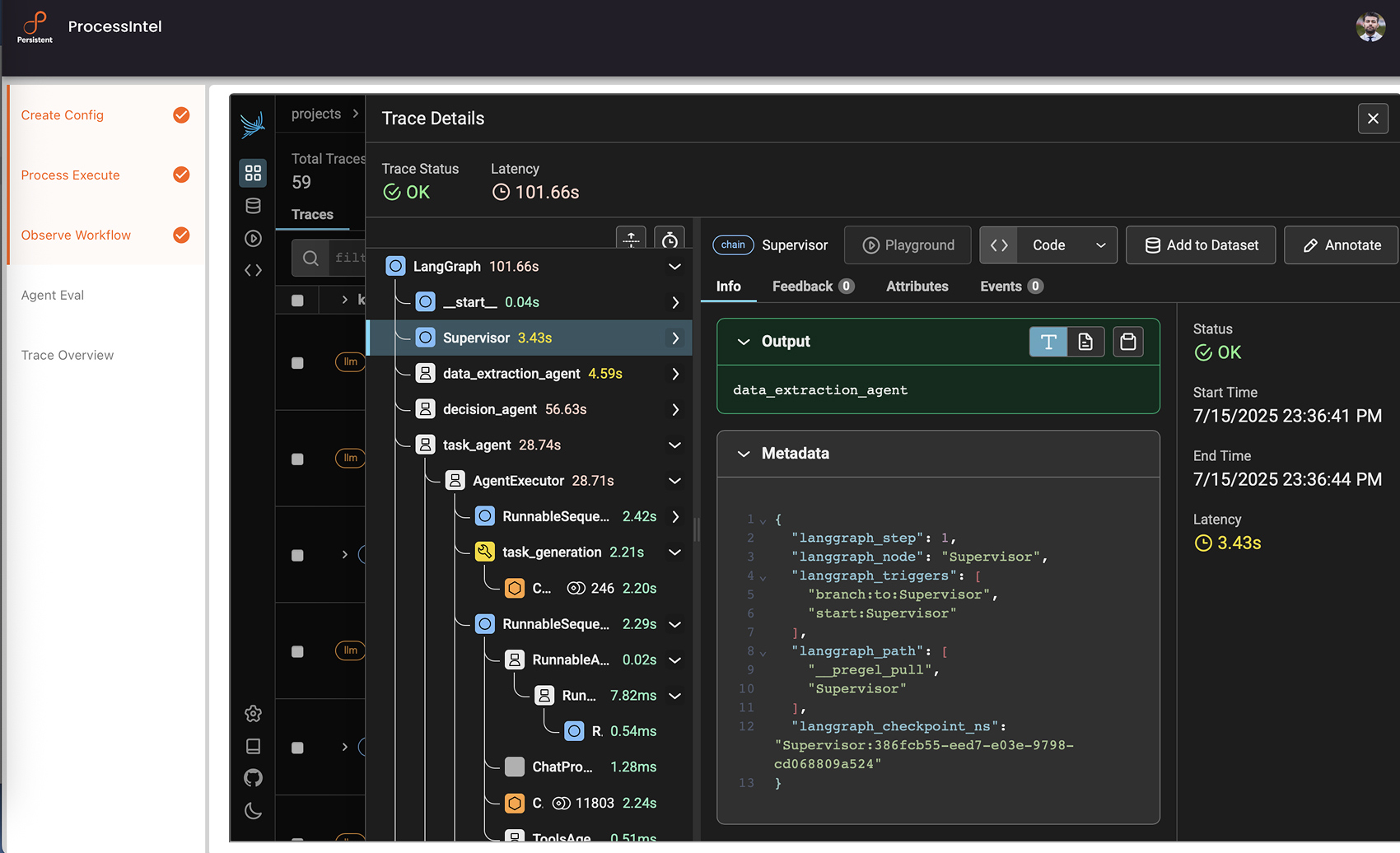In a previous blog, we explored how ProcessIntel which is a brand-new offering from Persistent reimagines business workflows by turning static workflows into intelligent, agentic systems. Now, we take a deeper look at the concept powering this transformation: Agentic Process Automation (APA). As a core capability of ProcessIntel, APA moves beyond the limits of traditional Robotic Process Automation (RPA), introducing intelligence, adaptability, and autonomy throughout the automation lifecycle.
ProcessIntel is not just about digitizing manual tasks. It’s about redefining what automation can do. By embedding agentic design at the centre of business processes, it enables systems to go beyond task execution to reason, reflect, and adapt. Let’s explore how this next-generation model works and why it surpasses conventional RPA approaches.
From RPA to APA: A Fundamental Shift
Traditional RPA platforms focus on automating rule-based tasks using bots that mimic user actions. While effective for repetitive work, these bots are rigid, struggle with exceptions, and lack the ability to respond intelligently to change.
In contrast, Agentic Process Automation, as implemented in ProcessIntel, introduces intelligent agents that can understand, optimize, and execute workflows in a dynamic, context-aware manner. This marks a shift from static task replication to adaptive process orchestration.
The Three Pillars of Agentic Intelligence in ProcessIntel
At the heart of ProcessIntel’s APA architecture are three specialized agents. Each plays a critical role in transforming and executing business processes:

- ProcessIntel Agent: Translating Processes into Blueprints
This agent acts as a translator and converter of existing process artifacts. Whether it’s RPA script files, Standard Operating Procedures (SOPs), process documents, or even domain-specific logic, this agent extracts actionable intelligence and structures it into a standardized configuration format — a YAML-based blueprint.
This YAML file becomes the semantic foundation of the agentic workflow — capturing tasks, dependencies, decisions, and even interaction points between agents. Think of it as the DNA of the future agentic system — cleanly structured and easily auditable, yet rich in logic and intent.
- Process Optimizer Agent: Enhancing with Reasoning and Reflection
Once the blueprint is created, the Process Optimizer Agent steps in. It applies domain-specific heuristics, integrates subject matter expert (SME) feedback, and leverages large language model (LLM) insights to refine the process. Using reasoning models like Llama 3.3 Nemotron, O3-pro, O3-mini, DeepSeek R1 it optimizes the workflow and process steps into a robust agentic workflow.
This agent doesn’t just tweak for speed. It builds resilience, adaptability, and awareness into the workflow, making it ready for real-world complexity. By integrating LLM-based insights and a reflection loop (a mechanism to evaluate and iterate on the process logic), it ensures that the transformed agentic workflow isn’t merely a mirror of its RPA predecessor, but a more intelligent, flexible version prepared for complex real-world execution. Where a traditional bot might break on unfamiliar input, an optimized agentic workflow can adapt, escalate, or course-correct in the moment.
- Process Execution Agent: Operationalizing the Agentic Workflow
The final blueprint is handed over to the Process Execution Agent, which brings the process to life within the agentic execution environment. This isn’t just about task execution — it involves real-time coordination among multiple agents, dynamic decision-making, and the ability to replan or adjust in-flight if certain conditions evolve.
As described in previous blog, it can leverage different agentic runtimes. It can also invoke agents using communication protocols like MCP, A2A and AGNTCY. Persistent has partnership with AGNTCY to implement industry leading security and governance.
Crucially, this agent isn’t a black-box executor. It is deeply integrated with monitoring tools and supports live introspection, observability, giving stakeholders visibility into performance metrics, error pathways, and execution states.
Building Trust: Observability, Profiling, and Agent Evaluation
ProcessIntel ensures enterprise-grade reliability through below components across the system –
- Observability: Provides granular insight into agent behavior, state changes, and decision pathways during process execution.
Fig 2: Workflow Observability Trace (Source: Persistent) - Agent Evaluation: Continuously assesses agent reliability and accuracy across scenarios to drive improvement and mitigate risk.
Fig 3: Evaluating Agent Output (Source: Persistent) - Profiling: Identifies performance bottlenecks, redundancies, and logic inefficiencies for optimization.
This layered intelligence is what allows APA to scale in production-grade environments where compliance, explainability, and uptime are paramount.
APA vs RPA: A Comparative Perspective
| Feature | Traditional RPA | Agentic Process Automation (APA) via ProcessIntel |
| Flexibility | Low – rule-based, hardcoded | High – adaptive, context-aware |
| Process Evolution Handling | Manual intervention required | Autonomous reflection and optimization |
| Knowledge Integration | Minimal, static logic | Integrates SME inputs, LLM reasoning |
| Error Handling | Predefined scripts, brittle | Dynamic resolution paths, fallback agents |
| Observability & Evaluation | Limited tooling | Built-in with profiling and agent insights |
| Inter-agent Coordination | Not supported | Native multi-agent orchestration |
Business Benefits of APA with ProcessIntel
The transition from traditional RPA to APA brings a step-change in enterprise automation, offering benefits that go well beyond cost efficiency:
- Operational Agility: Adapts in real time to policy, regulatory, or behavioral changes — essential in BFSI and healthcare.
- Reduced Manual Intervention: Agentic workflows self-heal, replan and escalate intelligently lowering reliance on manual exception handling.
- Process Resilience: Handles edge cases and recovers from anomalies more reliably than traditional bots.
- Faster Time-to-Value: Shortens deployment cycles for complex, high-impact processes like underwriting or patient case processing.
- SME Collaboration and Domain Knowledge Integration: Incorporates domain expertise directly into process design and optimization.
- Productivity Boost: Frees human workers (e.g., bank advisors or clinicians) to focus on value-driven decision-making and customer interactions.
- Continuous Monitoring: Ensures real-time visibility and performance tracking at every stage.
- Strategic Innovation: Enables rapid rollout of new products, workflows, or care pathways without sacrificing stability.
Ultimately, ProcessIntel enables organizations to shift from reactive automation to proactive, goal-oriented execution — positioning them for greater resilience and sustained growth.
ProcessIntel, powered by Agentic Process Automation, is not just an upgrade over traditional RPA — it is a paradigm shift. By shifting the focus from bots that follow instructions to agents that understand intent, optimize actions, and evaluate outcomes, we unlock a new era of automation that is not only more powerful but fundamentally more human-aligned.
As enterprises face growing complexity, shifting expectations, and the need for smarter operations, ProcessIntel offers a forward-looking path. It’s a future where automation isn’t just executed, but continuously evolved — intelligently, transparently, and at scale.
At Persistent, we’re redefining the future of work and operations using agentic workflows and agents that autonomously make decisions and automate job functions end to end.
Let’s reimagine your workflows together. Contact us to get started with ProcessIntel and Agentic AI.
Author’s Profile
Shilpa Ramteke
Senior Data Scientist, Innovation Labs AI Research









